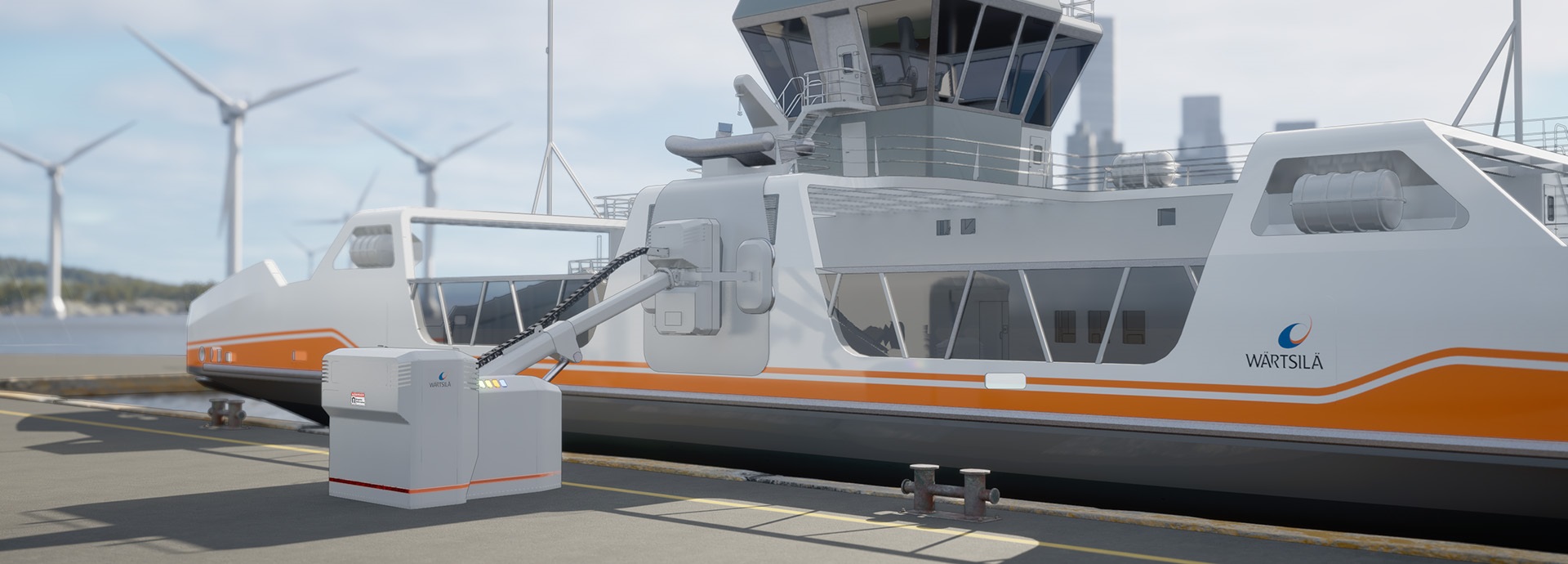

Vessel battery charging
Vessel charging solutions are designed for ships that have an energy storage system – for example a marine battery.
A marine charging system works in much the same way as a charging system for cars and other electric road vehicles.
Vessel charging systems are not yet standardized like alternative marine power (AMP) systems. They often require fast charging or DC charging, though normal charging or AC vessel charging is also possible.
The IEC 80005 standardized AMP system can be used for charging if the port stay is long enough, such as for RoPax or RoRo vessels.
Tailored charging solutions have the advantage of fast connection times, typically below 1 minute. This makes it possible for ferries to charge their battery during their short turnarounds.
The cable handling system is the most visible part of the charging solution, but the electrical engineering happens between the grid and the cable handling system to convert the medium voltage grid into the power needed for the vessel.
The advantage of tailored charging solutions is the fast connection time which is typically below 1 minute to allow charging for e.g. ferries at short turnarounds.
The most visible part of charging solutions is the cable handling system, although the electrical engineering is happening in between the grid and the cable handling system to convert the medium voltage grid into the power needed for the vessel.
AC and DC chargers
AC charger
The charging process starts with an AC charger that sends Alternating Current to the ship and converts it to Direct Current to charge the battery. In many cases, the ship's existing AC-DC converter can be used, which is the most cost-effective solution.
When the power demand for charging exceeds 5MW, a switch from low voltage (690V) to medium voltage (6,600V) is required. The IEC 80005 shore power standard is a type of medium voltage AC charger. Currently, the largest medium voltage chargers can transport power above 15MW.
DC charger
Batteries produce Direct Current (DC), so they can be charged directly with DC power. With a DC charger, there is no need for an additional converter onboard the vessel, and this saves space and weight. However, a converter is still required on the land side, making the DC charging solution often more expensive than an AC charger.
The largest DC chargers can deliver more than 7MW of power to the vessel. If even more power is needed, parallel systems are an option.
What is the difference between manual and automated chargers?
Manual chargers
A manual charger requires that a person - an operator - connects the vessel to shore, and this is its main disadvantage. On the other hand, manual chargers are cheaper, especially when using standard electric vehicle plugs like CCS 2 (Combined Charging System - commonly used for cars, up to 350 KW) or MCS (Megawatt Charging Systems - upcoming for trucks, up to 3 MW).
The MCS system has great potential in shipping and can already be used. However, it still has some limitations related to cooling and the lack of cables long enough for ship applications.
Wärtsilä made history by delivering the world’s first manual CCS 2 charger for a ship. This charger was installed on the fast, zero-emission passenger ferry MS Medstraum as part of the TrAM project.
Automated chargers
Automated chargers, also known as automated cable handling systems, can connect to a ship without a human operator in between. The charger on the land side uses electronic signals to locate its counterpart on the ship side of the vessel and connects automatically.
Examples of automated chargers include Zinus and Stemmann.
References
Finding the right solution involves considering various factors such as tides, ramps, and the location of the vessel to the berth. Recent installations by Wärtsilä include a fully electric, zero-emission solution for two Norwegian ferries and the selection of Wärtsilä solutions by Incat Tasmania for the world's first lightweight, zero-emission Ro-Pax ferry.
The Wärtsilä wireless vessel charging system replaces the traditional cable connection method. This type of marine battery charging system is particularly well suited to fully electric vessels that spend little time in port, such as ferries. Vessel charging can start the moment the ship docks, meaning that the same amount of energy can be supplied to the vessel over a longer time, reducing the total power rating requirement of the shore power charging station.
When combined with systems such as auto docking and vacuum mooring, docking and undocking becomes faster, safer and more efficient.



